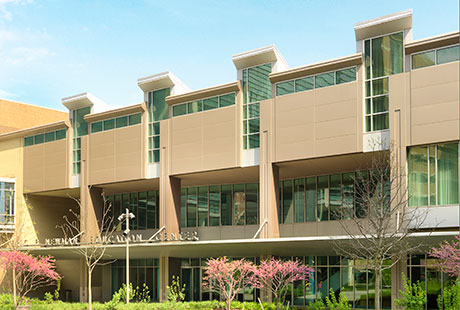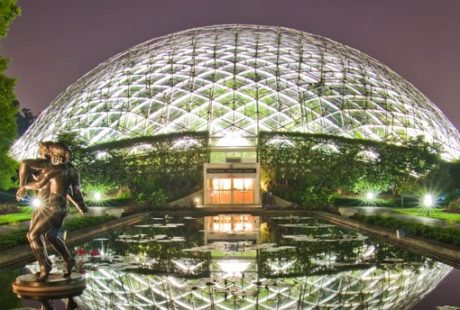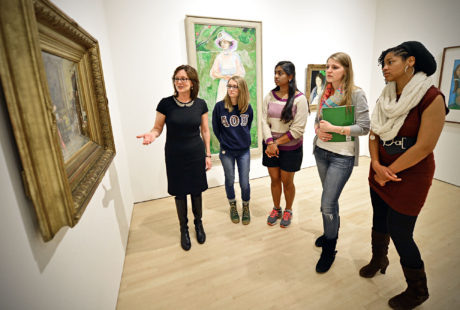Creating a Place Post
Create a post that includes an address and link to get directions.
Places is a custom post type that allows you to create multiple entries that can be grouped, filtered and formatted similarly. It is part of People, Places and Items.
Parts of a Place post
Tile
A Place’s tile includes a photo, name, brief description, address, contact information and summary.
It can link to a post detail page (see below), another website or nothing at all.
Where it appears
- On a page using the PPI: Individual block
- As part of a list on a page using the PPI: List block
- At the top of the Place’s post detail page, minus the summary
Post detail page (optional)
The post detail page, should you create one, is the Place’s page on your site. It can be accessed through a place’s tile or any other links pointing directly to it.
The tile appears at the top of the post detail page, followed by any text or images entered using the Place post.
How to create a Place post
From the left menu of your site’s dashboard, go to Places > Add New, or from the black admin bar at the top of any page, go to New > Place.
1. Add a title
- Type in a title, or name, for your Place. In most cases, this will be the name of the location. We recommend spelling out the full name and including any nickname or acronym in parentheses. e.g., Danforth University Center (DUC)
2. Add body text
- Skip this step if you included an external URL or plan to adjust your settings so that tiles don’t link to the post detail pages.
- Add and format the body content, below the post title, using the block editor. Content added here will appear in the post detail page.
3. Enter brief description text
- In the Additional Info section, you can add a brief description of the Place to display under its name on the tile.
- Make all of your Places’ descriptions consistent in content, length and tone.
4. Linking offsite (optional)
- By default, the name on the tile links to the Place’s post detail page.
If you would like the title to link to a different URL, such as the Place’s official website, enter that link in the External URL field.
If you don’t want the tile to link to its post detail page or an external URL, consider adjusting your PPI settings.
5. Complete the summary field
- In the Additional Info section, there is a large text box labeled Card Summary.
The summary only appears on the tile, which appears when a Place or a list of Places is inserted on a page using the PPI: Individual or PPI: List blocks.
The summary does not appear on the post detail page. So, if you want the same information to show on the post detail page, too, you’ll need to copy and paste it into the body content section, just below the title.
6. Add the physical location
- In the Places Fields section, enter your Place’s physical location in the Location/Map field above the Google Map.
- The address you enter will display on the tile with a location pin icon and create a Google Maps link.
7. Add the mailing address and contact information
- If your Place’s mailing address is different than the physical address, you can enter it underneath the map in the fields labeled Address Line 1, Address Line 2, City, etc. Remember to use the location’s Mail Stop Code instead of Campus Box, if it’s a WashU location.
- Next, you can add a Phone and Fax number.
- The address and contact information will display on the Place’s tile under the brief description.
- See below how the physical and mailing addresses appear on the tile »
8. Categorize the Place post
- If you plan to display or filter Places by type, create and assign categories under Places Categories in the panel on the right side of the screen.
9. Add an image or map
- You can show a thumbnail image or a mini map on your Place’s tile.
To show an image, go to the Featured Image box in the column on the right side of the screen and click Set featured image.
Upload or select an image from the Media Gallery that is at least 460 x 310 pixels. If you upload an image that is larger than those dimensions, it will be cropped from the sides and bottom to fit the space. Too small and it won’t display at all. - To show a mini map of the Place’s location instead of an image, you’ll need to adjust the settings for Places.
10. Save, preview, publish
- To save your work, click the Save Draft button in the top right corner.
- Click the Preview button to see what your Place’s post detail page will look like. It will open in a new tab/window; note that you will not see the summary since that content only appears on the tile.
- Exit out of the preview tab/window to return to edit view.
- If you’re ready for your Place post to be publicly viewable, click the Publish button; new changes can be published by clicking Update.
Place post examples
This tile for the Eric P. Newman Education Center includes an image, title, brief description, address and Get Directions button. A summary was not entered, so there is no summary on the tile.
If you click on the Place’s title, you’ll go to its post detail page.

Eric P. Newman Education Center
Conference center on the medical campus
- Physical Address: 320 S Euclid Ave, St. Louis, MO, United States
- Phone: 314-747-6338
- Fax: 314-286-2200
External link
If you click on the Missouri Botanical Garden title, you’ll be taken to its website, since it was entered in the External URL field.

Missouri Botanical Garden
The most beautiful place in St. Louis
- Physical Address: 4344 Shaw Blvd, St. Louis, MO, United States
Physical versus mailing address
The Program in Audiology & Communication Sciences’ physical address is 4560 Clayton Ave., represented by the location pin icon. Clicking the link generates Google Maps directions. The mailing address has an envelope icon and no link.
Program in Audiology & Communication Sciences
- Physical Address: 4560 Clayton Ave, St. Louis, MO 63110, USA
-
Mailing Address:
660 South Euclid Ave
CB 8042
St. Louis, MO 63110
Not recommended
In this example for the Kemper Art Museum, the physical and mailing address are the same but were entered in both fields, so they show up twice.

Kemper Art Museum
Part of the Sam Fox School of Design & Visual Arts
- Physical Address: 1 Brookings Dr, St. Louis, MO 63130, United States
-
Mailing Address:
1 Brookings Dr
St. Louis, MO 63130 - Phone: 314-935-4523
Up next
After you’ve created a Place post, you can add the Place’s tile to a page. Create a few more Place posts, and you’re ready to add a list (or grid) of tiles to a page.
Inserting an Individual Person, Place or Item (PPI)
Use the PPI Individual block to display a single faculty member, office location, research project or other post.
Inserting a List of People, Places or Items (PPI)
Use the PPI List block to create a dynamic list of staff, labs, publications and more.
Related Guides
Adjusting Settings for Places
Choose whether all of your place posts will display with an image or a map.
Creating a Person Post
Add people listings to your site by creating a separate post for each person.
Formatting Text
Add subheadings, body text, links, bulleted lists and more using basic formatting blocks.
Inserting a List of People, Places or Items (PPI)
Use the PPI List block to create a dynamic list of staff, labs, publications and more.
Inserting an Individual Person, Place or Item (PPI)
Use the PPI Individual block to display a single faculty member, office location, research project or other post.
Options for saving drafts, previewing and publishing content
Once a page is live, saved updates are publicly visible. Know your options for controlling the visibility of pages.
People, Places and Items
Use the tool for people, places or items to create directories, filterable lists and more.